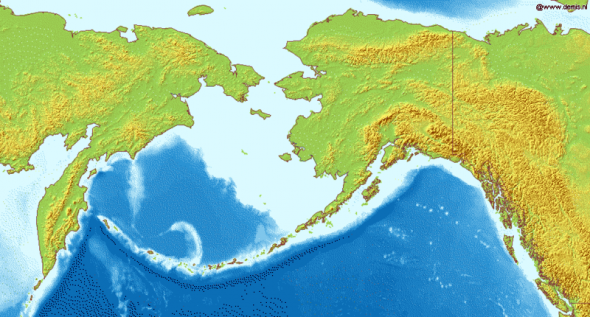2018 winter sea ice in the Bering Sea lowest in 5,500 years

The extent of winter sea ice measured in the Bering Sea in 2018 was the lowest of the last 5,500 years, according to a new study published in the journal Science Advances.
The researchers found that sea ice has decreased mainly due to its high sensitivity to changes in carbon dioxide that influence radiative inputs to the surface during the winter.
“The winter sea ice in the Bering Sea was long thought to be pretty stable over time, but these new results show how dynamic the sea ice is and how it is on a clear trajectory towards non-existence,” said Max Berkelhammer, University of Illinois Chicago associate professor of earth and environmental sciences and corresponding author on the paper. “This will affect not only ecological habitat in the region but will also likely accelerate warming across the Arctic.”

The researchers also found that sea ice extent may respond decades after changes in atmospheric carbon dioxide concentrations occur. This potential delay suggests that sea ice may not have fully responded yet to the increased carbon dioxide concentrations and warming in recent years resulting from industrialization.
“The sensitivity of the sea ice to warming and the fact that it may lag behind the current conditions implies we have already sealed a fate for a future with no winter sea ice by the end of the century,” Berkelhammer said.
Winter insolation, which is the amount of solar radiation that reaches the Earth’s surface during the winter, increased over the northern high latitudes over the last 5,500 years, a period known as the Holocene. This increase created warmer winters that gradually impacted sea ice extent in the Bering Sea.
“While this research found that winter insolation had a greater impact on sea ice extent than CO2 over the cumulative 5,500-year time period, radiative forcing from recent increases in greenhouse gas concentrations is on par with those increases in Holocene winter insolation, suggesting a sizeable reduction in winter sea-ice extent is likely to occur over a much shorter, decadal timescale,” said Miriam Jones, a scientist with the U.S. Geological Survey’s Florence Bascom Geoscience Center and lead author of the study.
The researchers used a collection and analysis of peat core containing plant tissue from St. Matthew Island, Alaska, that offered evidence of changes in sea ice and atmospheric conditions.
In a comparison between the plant tissue, which is created as the plant metabolizes precipitation, and atmospheric circulation patterns, the scientists suggest increasing flow of wind and atmospheric moisture entered the Bering Sea from the south over most of the late Holocene.
Because of the strong connection between the sea ice extent with the direction of atmospheric flow in the winter and spring, Berkelhammer and partners were able to show the atmospheric flow from the south reduces sea ice in the Bering Sea.
In addition to Berkelhammer and Jones, Katherine Keller of U.S. Geological Survey’s Florence Bascom Geoscience Center and Harvard University; Kei Yoshimura of the University of Tokyo; and Matthew Wooller of University of Alaska-Fairbanks are co-authors of the paper.
Funding support for the research came from the U.S. Geological Survey’s Climate and Land Use Change Research and Development and the National Science Foundation (grant 1502776).
